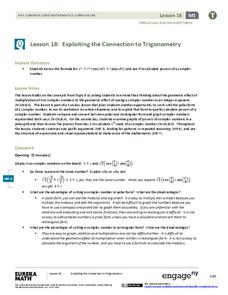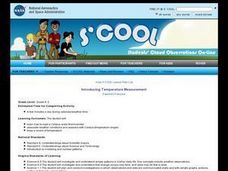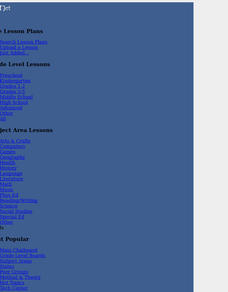G. Turrell
Science Activity 1: Light & Sound
Are you looking for lab sheets to go with your class experiment on plant response to light? You are no longer in the dark! This is a lesson that was written for a unit on light, but could easily be used to demonstrate plant behaviors in...
California Polytechnic State University
Australian Geography Unit
At the heart of this resource is a beautifully detailed PowerPoint presentation (provided in PDF form) on the overall physical geography of Australia, basic facts about the country, Aboriginal history, and Australia culture and lifestyle.
Curated OER
Fluency Passages, 6th Grade
Prompt your class to examine their own negative cycles with a short reading passage. After they finish reading, they answer two questions about concepts that they can find in the text.
US National Library of Medicine
Monster Genetics Lab
Harness young scientists' knowledge of genetics with an engaging science activity. Students start by flipping a coin to determine the genotypes and phenotypes of two parent monsters, before using Punnett squares to determine the...
Virginia Department of Education
Exponents
Expand your knowledge of exponents with an activity that promotes critical thinking and comparison skills. Middle and high schoolers compare numbers written in expanded and exponential form and explain their strategies for solving...
EngageNY
Similar Triangles in Circle-Secant (or Circle-Secant-Tangent) Diagrams
First angle measures, now segment lengths. High schoolers first measure segments formed by secants that intersect interior to a circle, secants that intersect exterior to a circle, and a secant and a tangent that intersect exterior to a...
EngageNY
The Multiplication of Polynomials
If you can multiply multi-digit integers, you can multiply polynomials. Learners use an area model to compare multiplying numbers to multiplying polynomials. They progress to using the distributive property.
Inside Mathematics
Graphs (2006)
When told to describe a line, do your pupils list its color, length, and which side is high or low? Use a worksheet that engages scholars to properly label line graphs. It then requests two applied reasoning answers.
EngageNY
Exploiting the Connection to Trigonometry 1
Class members use the powers of multiplication in the 19th installment of the 32-part unit has individuals to utilize what they know about the multiplication of complex numbers to calculate the integral powers of a complex number. Groups...
Code.org
Processing Arrays
Scholars use a playing card activity to help them develop a program to find the minimum value of a list. They learn to use for loops to write code that will process lists.
Poetry4kids
Rhyme Schemes Lesson Plan
Scholars read four brief poems and analyze their word usage in order to identify the rhyme scheme.
Curated OER
Limiting Reagent
Students work in small groups with a small set of 8 nuts and 5 bolts to assemble into combinations of 1 nut: 1 bolt, and 2 nuts: 1 bolt. They explore the outcome and discuss. Then a student mixes two clear, colorless solutions together...
Curated OER
Once in a Blue Moon
Third graders identify the phases of the moon. They use technology to access websites on the Internet dealing with the moon.
Curated OER
Rhythm Sticks
Second graders experience artistic perception of rhythm in music and see how to move their bodies and tap their sticks to the rhythm of a particular song.
Curated OER
Poster Assignment: Sports Chemistry
Tenth graders distinguish between chemical and physical properties and changes in matter when given specific examples. They view a video of sports activities. Students chose their favorite sport and design an experiment to improve sports...
Curated OER
Weather Patterns
Second graders discuss how their weather changes by examining temperatures, clothing needs, and plant life. They talk about the identifying factors of the seasons and complete a Venn Diagram about weather in a guided lesson. Next, they...
Curated OER
Matisse for Mother's Day
Students create a Mother's Day card with tissue paper flowers in the style of Henri Matisse.
Curated OER
Younger Generation
Students discuss the composer Aaron Copland and the lyricist Ira Gershwin and their significance in/contributions to American music of their time while singing the song "Younger Generation" in the choir setting. Emphasis is placed on...
Curated OER
Introducing Temperature Measurement
Students explore temperature and use Celcius thermometers to measure and graph the temperature in the classroom daily. They estimate what they think the temperature might be and then find the actual temperature in the room.
Curated OER
Treasure to Ship
Second graders explore and solve an algebraic word problem. They listen to a poem about pirates, describe the word problem in their own words, and independently solve the problem using colored rods to represent the pirates and treasure...
Curated OER
Concerto for Recorder, Oboe and Bassoon by Antonio Vivaldi
Students study the life and music of Antonio Vivaldi. They analyze and practice playing the various parts of Concerto a la Vivaldi on recorders. They record themselves and compare their performance to that of the same composition...
Curated OER
Seasons
First graders create a KWL chart about the four seasons. In this four seasons lesson plan, 1st graders continue the chart by watching videos and drawings.
Curated OER
Human Obstacle Course
Students are in a group - half of them be an obstacle and half be moving around them, and then they switch. This engaging game promotes lots of movement.
Other popular searches
- Repeating Patterns in Shapes
- Repeating Patterns Art
- Math Repeating Patterns
- Repeating Patterns Poetry
- Repeating Patterns Science
- Repeating Patterns in Math
- Repeating Patterns in Music
- Growing and Repeating Patterns

























